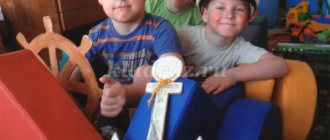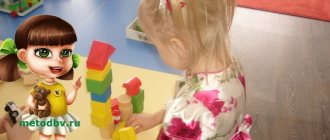Role-playing game "Bus"
Education Committee of the Berezniki City Administration
Summary of a plot-role-playing game for children of the middle group
"Bus"
Developed by: teacher M.V. Onkova
Berezniki, 2016
Thematic role-playing game “Bus”
middle group
Target:
Improve children’s ability to unite in play, assign roles, perform game actions, and act in accordance with the general game plan.
Tasks:
Educational:
- Develop the ability to change your role behavior in accordance with the different roles of partners, the ability to change the game role and designate your new role for partners in the process of unfolding the game;
- Improve children's dialogical speech;
- Teaching children to implement game plans.
Educational:
- Develop skills of social behavior in society;
- Develop interest in joint games;
- Develop communication and creative abilities.
Educators:
- Foster a culture of behavior in public transport;
- Develop communication skills, friendships and partnerships.
Expected result:
children will show interest in participating in joint role-playing games, participate in discussions of games, distribution of roles, and experience positive emotions when fulfilling the assigned role.
Activities:
gaming, communicative, educational.
Game roles:
driver, conductor, controller, passengers.
Preliminary work:
conversation on the topic “Modes of transport”, “Professions” and discussion of illustrations; children's stories about traveling on public transport; didactic game “Rules of behavior in transport”, watching the cartoon “Tram number ten was walking”.
Equipment:
pictures depicting a bus and passengers; children's chairs, steering wheel, tickets for passengers, bag for the conductor, doll, terry scarf.
Progress of the game:
Children sit on chairs, the teacher stands in front of the children.
Educator
: Guys, do you like to travel?
Children
: Yes!
Educator
: In order for us all to go on a trip, we need to choose transport. What would be the most convenient way for us to travel?
Children
: by bus.
Educator
: Okay, let's go with you by bus.
(Shows pictures of a bus and passengers).
The bus won’t go by itself, who do we need for this?
Children
: The driver, and there is also a conductor on the buses.
Educator
: That's right, guys. Now we need to build a bus, let's build it from our chairs.
(Together with the teacher, the children build a bus, distribute the roles of driver and conductor as desired).
Educator
: And then everyone else will be passengers.
(Children take their playing places).
Educator
: Guys, I'll give a radio alert. Is everyone ready? Has everyone taken their seats?
Children
: Yes!
Educator
: Be careful, the doors are closing. The bus starts to move.
(The driver imitates the movements of the steering wheel, passengers sit on chairs, the conductor hands out tickets).
Educator
: Stop, peace, carefully the doors open.
(Passengers get off the bus. Passengers at the stop enter the bus. The teacher, dressed as an elderly passenger, enters the bus. All seats are occupied).
Children
: Sit down grandma.
(give way).
Educator
: thanks guys.
(sits down)
. What great kids, I know that we need to give way to the older ones.
(They drive on. The children's voluntary actions. Dialogue between the children and the old woman. The bus arrives at the stop, the passengers change. The teacher changes clothes, takes the doll. Enters the bus.)
Educator
: Here guys, look how small my doll is.
(The children pay attention to her and give up their seat. Stop, the teacher gets out. He gets on the bus as a passenger).
Educator
: Guys, I see the controller is approaching, we need to get our tickets ready.
(In advance, the chosen role of the controller, walks along the bus and checks tickets).
Educator
: Guys, everyone’s tickets are in order, where should we go on our bus?
(Various answers from the children. They go on a trip).
Educator
: Oh, guys, a tire has burst on our bus. What do we do now?
Children
: We need to pump him up.
(Children play out the situation according to their own plans.)
Educator
: Well done, now we can move on.
Educator
: So our journey with you has ended. Did you like it?
Children
: Yes, I really liked it.
Educator
: Then next time you and I will definitely go somewhere else.
Role-playing game “Bus” in the younger group of kindergarten
Development and activation of the role-playing game “Bus” in the younger group for children 3-4 years old
Author: Dunaeva Nadezhda Valerievna, teacher of MBDOU “Kindergarten No. 63 “Yablonka”, Nizhny Novgorod Description: I offer you a methodological development on the topic “Development and activation of the role-playing game “Bus” in the younger group.” This material will be useful to preschool teachers when planning (organizing) role-playing games with children aged 3-4 years. The development is aimed at developing play in early preschool age. Objectives: 1. Plot development. — Contribute to the emergence of the game “Bus” based on observations from literary works. — Carry out simple plots in several actions, reflecting the actions of adults (the driver drives, the conductor sells tickets) — Display new events, bring something new to the “Bus” game. 2. Development of the game as an activity (goal, motive, means, methods, result) - Come up with a simple plot, choose a role, perform several interrelated actions. — Improve objective actions: substitute toys, imaginary ones. — Improve role-playing statements that indicate the execution of actions: addressing yourself, a toy, a partner. A brief spoken conversation appears. 3. Formation of relationships - Cultivate a friendly attitude towards each other, encourage the timid, including them in the common game. — Unite into small groups based on personal sympathies. -Individual and joint decision of game actions, accept game actions, tasks from peers. 4. Formation of independence and creativity - Develop independence in choosing a game, in implementing plans, encourage independence in selecting attributes for the game; supplement the game environment with missing items. — Creativity in choosing objects and methods (they themselves select substitute objects). 5. Develop skills: - take on a role and designate it for a partner; - carry out role-specific conditional objective actions; - develop specific role interaction - role dialogue; - change role behavior during the game depending on the roles of the partners; - change your playing role depending on the unfolding plot.; - implement specific role-playing actions aimed at the toy partner, develop partner role-playing interaction, elementary role-playing dialogue with the peer partner; - develop the games of each child based on his personal interests. Management methodology: Component I “Familiarization with the surroundings in active activities. Enriching real-life experience" - Excursion to the bus stop with a teacher. — Monitoring the movement of buses, the actions of people at the bus stop. — Reading thin. Literature: A. Barto “Truck” - A conversation with children about their trips on the bus with their parents, What they liked. — Examination of the painting “Riding the Bus” (series “We Play”); illustrations (bus, passengers, children on the bus); toy bus. — Direct educational activities: a) drawing “Wheel Shop” b) application “Bus” c) construction from building material: “Bus”, “Car Stop” d) musical development: music. Potalenko, words by N. Naydenova “We are going, going, going” II component “Enriching the gaming experience” - Did / game “What’s extra?”, “Match the wheel to the car”, “Colored cars” - Game-dramatization of A. Barto’s poem “Truck” - Game exercises: “The driver announces a stop”, “Passengers board the bus” - Outdoor game “Sparrows and cars” - Joint game between the teacher and the child: the teacher starts the game, takes on the main role of the bus driver, then involves the child in a joint game, offering him an additional role - a passenger, and then gives up his role to another child, that is, the teacher “locks” the children into each other. — A joint game between the teacher and the child: the teacher guesses what the child is playing (Q: who are you? Child: I’m the driver) and joins the child’s game (Q: can I sell tickets?) - role-playing interaction unfolds, then the teacher involves the other child, “short-circuits” the children to each other, and leaves the game herself. — “Phone” — the dispatcher calls the bus driver, calls him to work; calls the conductor and asks him to come to the control room to get tickets. The bus driver then talks on the phone to the conductor. The teacher can offer to talk “to the driver with the passengers” - A joint game between the teacher and the child along the river. n. fairy tale: The teacher takes the role of the main character “kolobok”, involves the children in the game, talking with each child individually (with a wolf, a hare, a bear, a fox). You can involve 3-4 children in such a game, but you can do more - let the bun meet another hare. III component “Enrichment of the gaming environment” - Attributes for the game: environment-forming objects, large floor builder, modules, steering wheel, traffic light, driver’s cap, conductor’s bag. — Real toys: buses, cars, dolls, passenger toys. — Children and their teacher make squares—tickets. IV component “Guidance during a child’s independent play” - Help in distributing roles (at first Dima will be the bus driver, and when his shift ends, Misha will be the driver) - Creating a problem situation (The bus tire has burst, we will help to repair it) - Remind the children that in transport you need to behave quietly, carefully, and be polite. — Learn to negotiate joint actions. - Analyze the game, children’s participation in the discussion of the game.
We recommend watching:
Thematic role-playing game for older preschoolers Fashion Atelier Thematic role-playing game in kindergarten Thematic role-playing games in kindergarten Thematic role-playing games in preschool educational institutions
Similar articles:
Role-playing game in early preschool age
Games, songs, exercises for younger preschoolers “Igralochka”
An outdoor game with elements of a role-playing game for children 4-6 years old
An outdoor game for middle and high school children
An outdoor game with elements of a role-playing game “Fun Bus”
Author: Marina Vladimirovna Rukavishnikova, teacher of MBDOU No. 91 “Voice”, Bratsk, Irkutsk region. Description of material: entertainment scenario for children 4-6 years old (middle, older group). The material may be of interest to educators. The scenario can be divided into two games: an outdoor game, which can be played both in a group and on a walk with children, and a role-playing game “bus”. Goals: to develop children’s coordination of movements, dexterity, and enrich the motor system. To develop children’s ability to correctly select attributes for the game and complete assigned tasks. Strengthening children's ability to communicate with friends by playing a certain role. Creating a joyful mood. Attributes for the game: chairs, steering wheel, conductor's bag, tickets, hoop. PROGRESS OF THE GAME: Presenter (teacher): Guys, you’re feeling sad... do you want us to play? Children: yes! Presenter (teacher): Let's take a ride on the bus, not just a regular one, but a “Vesyoly” one? Children: Let's go! Presenter (teacher): But where can we get a bus? Let's build it! Children use chairs to build a bus. Presenter (teacher): So our bus is ready... Who usually drives the bus? Children: (children's answers)
driver, driver.
Presenter (educator): Who works with the driver? Who gives tickets to passengers? Children: conductor Presenter (teacher): Correct! Well done - you know everything! This means we need to choose a driver and conductor for our Fun Bus. Let's stand in a circle. (children stand in a circle) Guys, what does a driver need to drive a bus? Children: ( children's answers)
steering wheel!
Presenter (teacher): That's right - steering wheel! Here it is (shows the steering wheel). With the help of this steering wheel we will find a driver for us. I will turn away, and you pass the steering wheel to each other in a circle. As soon as I say “stop”, you stop, and whoever has the steering wheel in his hands will be the driver. Ready? Let's start! (choose a driver) Presenter (teacher) : Here is our driver. Your role is to drive the bus. At each stop, after passengers take their seats on the bus, you must say: “Careful, the doors are closing! Let's move on! " Get on the bus. (sits down)
Did you forget the words?
Driver: “Careful, the doors are closing! Let's move on! " Presenter (teacher): Now we need to choose a conductor. We will also choose, only this time we will hand over the bag to the conductor. Ready? Let's start! (Choose a conductor) Presenter (teacher): Conductor, look what’s in your bag? Of course tickets! You must give tickets to passengers and escort them to their seats on the bus. How are you going to do that? Conductor: Here's your ticket! Please sit down here! Presenter (teacher): Well done! You are an excellent conductor! And we guys will be passengers, and we will board the bus at different stations. Look, I’m putting a hoop in the center of our circle. We will walk with you in a circle, one after another, and sing a magic song. As soon as the song ends, 3 people must jump into the hoop. Whoever takes a seat at the hoop (stop)
will ride on the bus.
Shall we try? The wheels are spinning (the children pretend to be steering with their hands)
The motors are knocking
(we are spinning or knocking with our fists)
Our cheerful bus is calling for a ride for the kids!
Children jump into a hoop. We warn them not to push each other. The presenter announces a stop. Presenter (educator): Stop “Smeshilkino” Guys, if the stop is called “Smeshilkino”, what should the guys do at this stop? Children: laugh! Presenter (teacher): Correct! Laugh! (children in hoops laugh) Well done, you can get on our “Fun Bus” Conductor: Here is your ticket! Please sit down here! Driver: “Careful, the doors are closing! Let's move on! " Presenter (teacher): Let's move on! (repeat the song and movements)
Children and presenter: Wheels are spinning, Motors are knocking... Our cheerful bus is calling for a ride for the kids!
Presenter (teacher): stop "Dancevalkino" The game continues until all the children get on the bus. Stop options: “Stoyalkino on one leg”, “Prygalkino”, “Prisedalkino”, “Quickly Pomorgalkino”, etc. The last stop is “Opazdalkino” - you need to depict fast running on the spot. All the children received tickets from the conductor and are sitting on the bus. Driver: “Careful, the doors are closing! Let's move on! " All the children, already sitting on the bus, repeat the song with movements.
The wheels are spinning, the motors are knocking... Our cheerful bus brought us to kindergarten!
Presenter (teacher): stop “Kindergarten” So we arrived back to our kindergarten... Oh, look, the driver of the Fun Bus turned back into our (child’s name), and the conductor turned into our (child’s name), and the Fun Bus turned into our chairs, which need to be placed in their places.
We recommend watching:
Outdoor games for preschool children Games for younger preschoolers on the topic Animals Organization and conduct of outdoor games in various types of activities Outdoor games for children 3 years old
Similar articles:
What is a plot-based role-playing game?
Outdoor games for children aged 1, 2, 3 years
Outdoor game for children “Birds of Migratory”
Outdoor games for children 3-4 years old in kindergarten
Outdoor games for preschoolers in kindergarten






